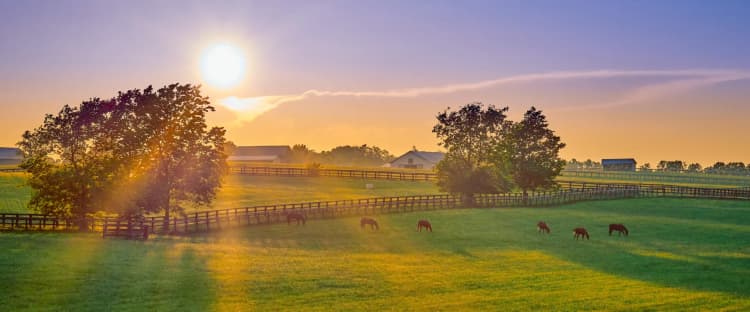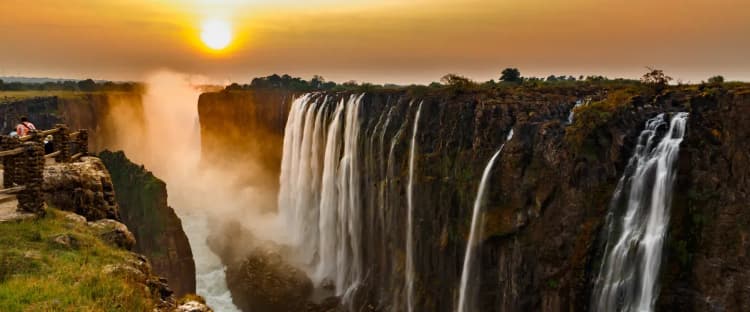
Thailand Itinerary: 1, 2, or 3 Weeks
Table of Contents
Thailand is known as the “Land of Smiles," and whether that’s because the locals are so friendly or because you’ll surely be grinning for the entirety of your stay, the nickname is spot on. Book for a quick week or a whole month—there is no shortage of things to do in this Southeast Asian country. Wander through the temples of Bangkok, walk through the national parks or over a sticky waterfall outside of Chiang Mai, cook (and then eat) a fresh Thai feast, ride a longtail boat along the coastal limestone cliffs. In Thailand, you’re bound to find the adventure that you’re craving.
Ready to go? Check out our cheap flights to Thailand from your airport.
How to spend 1 week in Thailand
Bangkok: 2 days

Thailand’s capital city of more than 11 million people, Bangkok is the epicenter of hustle and bustle in this country. In a few words: You either love it or you hate it. Rivaling major Middle Eastern and African cities, Bangkok is one of the hottest cities in the world, with consistently high temperatures year round. There are also tons of people around—always—meaning the traffic is no joke.
Bangkok also houses striking and sumptuous temples, a vibrant food scene where mango sticky rice rubs shoulders with grilled frog skewers, and plenty of green spaces if you know where to look.
Bangkok is a city that will swallow you whole, take you for a ride, and spit you back out, leaving you feeling like you’ve seen all that your eyes can handle—but also like you’ve only just scratched the surface. Two days is the perfect amount of time to spend in this megalopolis, especially if you’re only here for a week.
What to do in Bangkok
Bangkok’s temples are a sight to behold. Go to the Grand Palace for, well, grandiosity; at more than two million square feet, the complex is the former residence of kings Rama I through Rama V and hosts the Temple of the Emerald Buddha. Wat Pho holds Thailand’s largest reclining buddha. Wat Arun sits on the bank of the Chao Phraya River—you can climb the grand pagoda for river views, and at night, the temple is illuminated a brilliant gold. Wat Saket is perched on a man-made hill, the only hill in Bangkok, offering views of the city skyline. The ancient Wat Mahathat is part of the historic city of Ayutthaya, the second capital of the Siamese Kingdom and now a UNESCO site. Wat Suthat features a giant swing at its entrance and a cloistered courtyard containing 156 statues of the Buddha.

You can also eat your way through the capital. One of the largest in the world, Bangkok’s Chinatown offers Thai twists on Chinese classics—shrimp dumplings, roasted duck, and crab noodle soup to name a few. Head to Khao San Road for adventurous bites like fried scorpion and mainstays like Pad See Ew. Or hop on a chef-designed street food tour, complete with a water taxi and tuk-tuk ride and all of the under-the-radar Thai street food that your stomach can handle.
If shopping is your thing, Bangkok is a playground. Malls like ICONSIAM and Siam Paragon have all of the big-name stores like Gucci, Coach, and Michael Kors. For more local shopping, visit the Chatuchak Weekend Market, Pak Khlong Talat (a 24-hour flower market), or a famed floating market.

To escape the crowds, head to Lumphini Park—the first and largest park in Bangkok—where you can join the locals in Tai Chi, rent a paddle boat for a spin around the lake, or spread out a blanket under a canopy of trees. Wander around the house and museum of the late Jim H.W. Thompson, an American businessman who was also known as the “Thai Silk King.” The old wooden house is now a museum, which showcases Thompson’s architectural skills, his collection of Asian antiques, and the surrounding lush gardens.
Getting to Bangkok
The nearest major airport is Bangkok Suvarnabhumi International Airport (BKK), located about 20 miles from the city center.
Getting around Bangkok
One of the cheapest and easiest ways to get around Bangkok is by metro or Skytrain. Fares start less than $1 for a one-way ticket. You can also use Grab, the Southeast Asian version of Uber, to call a scooter or car. Taxis are also common throughout the city, but be aware that you should settle on a price with the driver before beginning your journey; also, traffic in Bangkok can be dreadful, so you might not want to travel by car if you’re in a hurry. Finally, you can also take a tuk-tuk—a three-wheeled open vehicle—throughout the city. While this may be the most exciting way to get around Bangkok, it is usually more expensive than traveling by car and you still have to deal with traffic.
Tip: It’s helpful (for you and the drivers) if you have a screenshot of the address you’re trying to reach.
Chiang Mai: 2-3 days

If Bangkok is Thailand’s beating heart, Chiang Mai is its lungs. A crucial stop on any Thailand itinerary, mountainous Chiang Mai—accessible via a one hour and 15 minute plane ride from Bangkok—offers a welcome respite from the chaos of the capital. As the largest city in Northern Thailand, it is also buzzing with tourists, but it offers more breathing room, slightly lower temperatures, and ample opportunity to explore the area's green spaces.
What to do in Chiang Mai
Like Bangkok, Chiang Mai is home to lavish temples. Wat Phra That Doi Suthep—aptly named, as it sits adjacent to Doi Suthep mountain—is one of the most sacred temples in Thailand and offers sprawling views of surrounding Doi Suthep-Pui National Park and Chiang Mai below. Wat Chedi Luang gives off ancient vibes. Wat Umong is famous for its system of tunnels. The near-entirety of Wat Sri Suphan sparkles in silver. Wat Lok Molee boasts stunning Lanna architecture—characterized by steep-pitched, multi-tiered roofs. And Wat Phra Singh houses Northern Thailand’s most distinguished Buddha, a giant gold statue.
Get out into nature on a hike through one of the area’s parks, such as Doi Suthep-Pui National Park or Doi Inthanon National Park, which is located about 56 miles from Chiang Mai and features waterfalls, remote villages, and prime viewpoints for watching sunrise and sunset. You can also visit Bua Tong Sticky Waterfall, located about 37 miles north of the city, where the cartoon-like stones beneath the flowing water have such great grip, you can basically glide down them like you’re walking on water (just be sure to hold on to the provided ropes for balance, as the sticky waterfall isn't so sticky in parts). Or take a bamboo raft down the Wang River in Mae Wang, a Chiang Mai subdistrict. While you can opt to go with or without a guide, hiring a guide allows you to appreciate the jungle and wildlife without the physical exertion.

If you’re dreaming about the opportunity to walk among elephants, Chiang Mai is home to a top-tier elephant sanctuary: Elephant Nature Park. As a leading rescue and rehabilitation center, you can feel good about coming to this ethical establishment. There is absolutely no riding or expectation that the elephants are there for your entertainment. Instead, you have the privilege of walking around huge, expansive grounds that allow many senior elephant rescues to enjoy their later years. For a special treat, you can see young calves—lovingly nicknamed the “trouble makers” for their unbroken spirit—playing. It’s clear that the people who work here deeply care about each individual elephant, as well as helping the world understand more about the gentle giants and how to protect them.

There are also plenty of shopping opportunities in Chiang Mai, like at the night bazaar—where you can pick up locally made crafts, art, jewelry, and more—or the Baan Kang Wat art village, which features artisans selling things like wooden cutting boards, ceramics, and home decor.
You won’t want to miss the food scene in Chiang Mai, which surprisingly differs from the cuisine of southerly cities. Hop on a tasting tour and try regional dishes like charcoal-roasted pork and coconut khao soi curry; khao soi originated in Chiang Mai, and while you can find it in other cities, they’re not nearly as good as Chiang Mai’s. (Khao Soi Mae Manee, a Michelin-star shop that’s much more humble than its guide counterparts, serves up a killer khao soi here.) Or you can try your own hand at Northern Thai cooking—this cooking school lets you choose four courses from a long list of possibilities, all made with organic ingredients.

Getting to Chiang Mai
The nearest major airport is Chiang Mai International Airport (CNX). There are quick and regular flights (about an hour and a half long) from Bangkok to Chiang Mai via major airlines. You can also take a train (13 hours) or bus (10 hours), which, while longer, allows you to enjoy the landscape.
Getting around Chiang Mai
Tuk-tuks are the cheapest and easiest way to get around Chiang Mai. It’s also pretty easy to catch a Grab here, as well as songthaews; these are red covered pickup trucks that allow you to get all around the city at all hours of the day—and meet other travelers along the way. To have a little more control over where you go and when, you can rent a bicycle—many hotels have them on offer. At the end of the day, Chiang Mai is a very walkable city, so when in doubt, lace up your walking shoes.
Gulf of Thailand Island: 2 days

A trip to Thailand wouldn’t be complete without island vibes—and here, there are plenty of them. Thailand is surrounded by two bodies of water: the Andaman Sea to the west and the Gulf of Thailand to the east. While a week should be enough time to get to either (but maybe not both if you’re planning to spend time in both Bangkok and Chiang Mai), the islands on the gulf side are a little closer and, therefore, more easily accessible on such a short timeline.
In Thai, “koh” or “ko” means island. While you can’t go wrong visiting any of the islands here, each one comes with its own distinct atmosphere—do your research before traveling to decide which one fits what you’re looking for.
Koh Samui

Incredibly easy to get to and one of the more trafficked islands in the gulf, Koh Samui is best for families and those looking for luxury. (In other words, it’s not the place if you’re looking to “rough it.”) Koh Samui boasts Michelin-recommended restaurants and accommodations, plush spas and retreats, and some of the best shopping that the Thai islands have to offer. Intrepid travelers should visit Ang Thong National Marine Park, located a short boat or kayak ride away, for a steep walk that gets your blood pumping and expansive views of electric-turquoise water and leafy protuberances of land. (Wear tennis shoes, and bring plenty of water.)
Koh Tao

Koh Tao is a scuba diver’s—or aspiring scuba diver’s—paradise. Countless dive schools make it easy for you to secure your PADI or SSI Open Water Certification, which takes about four days to complete. If you don’t have that long, opt for a discovery dive; you can do a guided 12-meter dive without certification. (But trust us, you’ll likely end up extending your stay on the island to include more advanced dives, like wreck dives, night dives, or Nitrox dives.) At eight square miles, Koh Tao is small, with a tight-knit community (much of which is expats), and a low-key nightlife scene to boot—though those looking to rage should head to neighboring Koh Pha Ngan.
Koh Pha Ngan

Revelers rejoice—Koh Pha Ngan is the place to be for drinking and dancing into the wee hours of the morning (luckily, there are also quiet beaches and luxe spas on the island to recover from the prior evening’s festivities). Koh Pha Ngan hosts Thailand’s full moon parties on Haad Rin Beach. But if you’re not in town during the right time of the month, don’t worry: There are also half moon and black moon parties every other week of the month. If you’re looking for a break from the action, there’s also the Thong Sala Night Market for eating, shopping, and wandering, or you can hike up Khao Ra mountain, a 3.8-mile, out-and-back trek summiting Koh Pha Ngan’s tallest peak.
Getting to the islands in the Gulf of Thailand
The best way to get to the gulf islands is via ferry, which sets off from Donsak Pier in Surat Thani (just over an hour-long flight from Bangkok). The ferry from Surat Thani to Koh Samui, the biggest of the islands, is about 1.5 hours. From Surat Thani to Koh Pha Ngan, it’s about 2.5 hours, and to Koh Tao, it’s about 3.5 hours.
Getting around the islands
Songthaews (red pickup taxis) are the most common and cheapest way to get around the islands. You can also rent motorbikes or bicycles—just be sure to mind the rules of the road and drive with caution.
How to spend 2 weeks in Thailand
With an extra week in Thailand, there’s plenty of time to delve deeper into the destinations you slated for week one; consider adding an extra day or two onto each of those stops, particularly in Chiang Mai and the gulf islands.
That being said, there are plenty of other areas to explore around Thailand. While some are the perfect side trip from a destination you were already planning to visit (like a relatively quick ride from Chiang Mai to Chiang Rai), others—like Krabi and Phuket—are such incredible destinations, you simply wouldn’t be able to get a good taste of the places in a single week in Thailand. But with two weeks, there’s no excuse not to dive in.
Chiang Rai: 2 days

Often in the shadow of its southern neighbor Chiang Mai, Chiang Rai is certainly not second-best. It sits three hours farther north, requiring a bit more time and organization to access, but once you have reached it, you won’t be disappointed. The mountainous province of the same name boasts arguably the most beautiful temples in Thailand, a complex cultural blend (given its proximity to Laos and Myanmar), and the ultimate relaxed atmosphere.
What to do in Chiang Rai
Chiang Rai is a chromatophilia’s playground, as color is at the forefront of most attractions.
Wat Rong Khun—more commonly known as the “White Temple”—will likely be your first stop, and for good reason. One of the most recognizable temples in Thailand, Wat Rong Khun is not only painted a brilliant white, it also contains glass in its plaster, making it sparkle in the bright Southeast Asian sunlight. (The temple was severely damaged after a 2014 earthquake but has since been restored and is again welcoming visitors.)

On the opposite end of the spectrum, you can visit Thai artist Thawan Duchanee’s Black House, more formally known as Baan Dam. Composed of about 40 different structures, the entire complex—part-museum and part-studio—is decorated with deep, imposing colors and wood, as well as disturbing decor like skulls, horns, and taxidermy.
There’s also Wat Rong Suea Ten—think Blue Man Group in temple form—and Wat Phra Kaew, whose name you might recognize from your sojourn in Bangkok. Chiang Rai’s Wat Phra Kaew was the original home of the Emerald Buddha, where it was found in the 15th century before being relocated to the capital.
Like most major Thai cities, Chiang Rai has a night market where food, handicrafts, and massages are abundant. And if the great outdoors are more your speed, there is plenty of it. Hike through Lum Nam Kok National Park, bisected by the Mae Kok River and containing a handful of waterfalls. Or visit Singha Park—a former family-owned farm where the barley was grown to produce Thailand’s own Singha beer. Now, in addition to plantations, it hosts flower gardens, meadows, lakes, and trails perfect for bicycling.
Getting to Chiang Rai
You can fly from Bangkok to Chiang Rai International Airport (CEI) in about an hour. You can also take a bus from Chiang Mai to Chiang Rai, which takes about 3.5 hours.
Getting around Chiang Rai
Chiang Rai is a very walkable city if you are able to get around on foot. You can also expect to see a lot of tuk-tuks, which come in handy if you’d like a lift.
Krabi and Phuket: 4 days

Long white sand beaches and limestone cliffs blanketed in trees protruding from the turquoise water—Krabi and Phuket are your answers to a Thai beach holiday. Krabi is home to world-famous sandy stretches and off-shore geology that’ll make you do a double take. While there’s plenty to experience in Krabi itself, its shores are also great jumping-off points for equally wondrous islands on Thailand’s Andaman Sea side, including Phuket.
What to do in Krabi and Phuket
While there are temples and markets to indulge in, Krabi and Phuket are beach-centric. So if you’re planning a visit here, you’d better pack a swimsuit (or two). The majority of your time will be spent splashing in the surf, exploring the coral reefs, boating along the coast, and ducking into craggy caves.
Railay Beach and Ao Phra Nang Beach in Krabi are two of the more epic beaches in Thailand (and probably the world). Take a longtail boat ride to one of the nearby islands:
- Koh Phi Phi: The filming location of “The Beach” (starring Leonardo DiCaprio) and features the famous Maya Bay
- Koh Lanta: Quiet destination with waterfalls, hippie bars, and a national park
- Koh Yao Yai and Koh Yao Noi: The two largest islands in the Koh Yao island group with quaint villages and a jungle atmosphere
- Koh Hong: A group of small islands in Than Bok Khorani National Park, home to Hong Lagoon (only accessible by squeezing a boat through Krabi’s picturesque limestone cliffs)

Phuket is a large island just off the mainland, and while it is touristy, it’s that way for a reason. The island has a robust nightlife scene—including everything from sandy beach bars to raging clubs. It also has top-notch viewpoints, including Laem Phromthep and Samet Nangshe, the latter where you can see those limestone cliffs from a much higher vantage point. Like Krabi, it has no shortage of beaches to while away your days, like Freedom Beach, Laem Singh Beach, and Ya Nui Beach, all of which tend to be less trafficked than some of Phuket’s other hotspots. The Great Buddha of Phuket, a massive white marble statue, is also a must-stop-by.
Getting to Krabi and Phuket
Both have an airport with regular flights from Bangkok: Krabi International Airport (KBV) and Phuket International Airport (KBV).
You can get between Krabi and Phuket a few different ways, with the easiest being by ferry or bus, each taking 2.5-3 hours.
Getting around Krabi and Phuket
You can easily order a Grab in both Krabi and Phuket. (Taxi drivers may tell you that Grabs don’t pick up here; on the contrary, Grab does pick up from the airport, just in the parking garage, and they tend to be cheaper than regular taxis.) Tuk-tuks and songthaews are also common. Take the scenic route by cruising around the area on a longtail boat.
How to spend 3 weeks in Thailand

Three weeks in Thailand—lucky you! With those extra days, you’ll have the opportunity to venture farther afield to some of the country’s less trafficked areas. (Trust us: While less trafficked than areas like Bangkok and Phuket, there’s nothing quiet about Pattaya!)
Pai

While you’re in the north visiting Chiang Mai and Chiang Rai, stick around Pai for a few days. A mountain village in the Mae Hong Soon province, Pai is pure Zen, popular with backpackers and those craving a bohemian lifestyle. Experience some of Thailand’s best natural wonders—take a walk on the rocky side in Pai Canyon, float above the rice paddies on the Bamboo Bridge, explore Tham Lod Cave, rent a raft to float down the river, soak in nearby Tha Pai Hot Springs and Sai Ngam Hot Spring, or get above the clouds at Ban Jabo Viewpoint.
Pattaya

Much of where you’ll likely visit on the mainland of Thailand lies to the west of the Gulf of Thailand. For a change of scenery, venture to the east of the gulf to Pattaya, a beachy city popular for its nightlife and family-friendly activities. Pattaya is home to an array of expats, meaning the food scene is far-reaching, including French, German, Indian, Chinese cuisine—and beyond. During the day, there’s bungee jumping, skydiving, Muay Thai (Thai boxing), and golf; by night, hit up Walking Street, an entertainment hub full of bars, clubs, and pool parties.
Khao Sok National Park

If Pattaya is where you go to let loose, Khao Sok National Park is where you go to unwind. Located in the Surat Thani province—between Krabi and Koh Samui—it’s the largest evergreen forest in the world and is composed of limestone mountains, lakes and caves, and an impressive array of flora and fauna. (Fun fact: The area that the park now occupies was created during the same tectonic shift that created the Himalayas.)
You could spend an afternoon tromping around the park or several days on a proper safari. Be sure to include the manmade Cheow Larn Lake on your itinerary, and hop on a guided tour to safely maneuver the forests where tigers, leopards, and sun bears also roam.

Published December 13, 2023
Last updated December 21, 2023
Articles you might like
View AllTreat your travel to cheap flights
Most deals are 40-90% off normal prices with great itineraries from the best airlines. If it's not an amazing deal, we won't send it. Sign up for free to start getting flight alerts.



